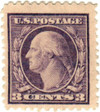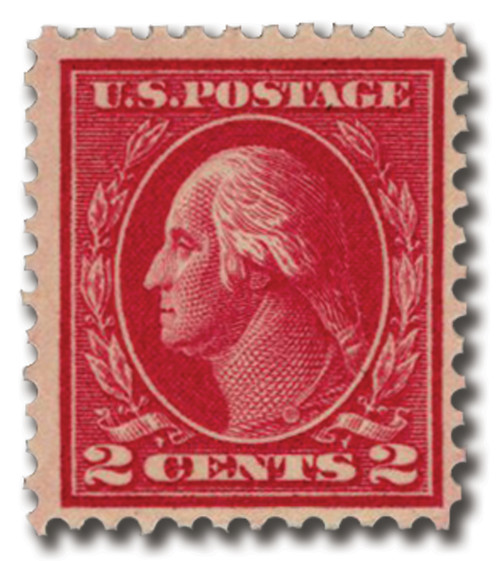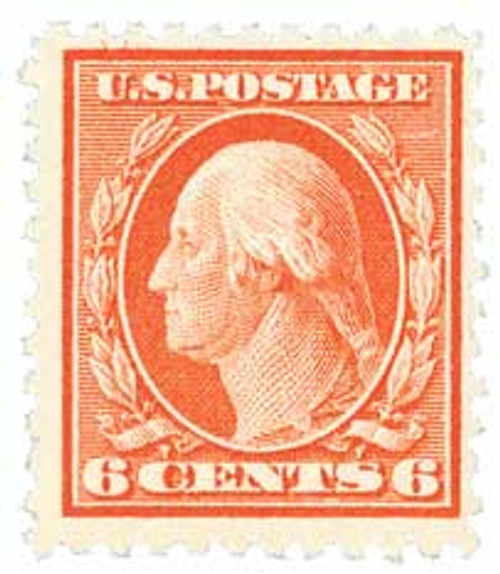
# 502 - 1918 3c Washington, violet, type II
U.S. #502
1917-19 3¢ Washington
Type II
World War I presented a peculiar difficulty for the Bureau regarding the 3¢ Washington stamps. Most of the high-quality ink came from Germany, and those supplies were interrupted. The quality of replacement inks was often inconsistent, resulting in a scattered range of color shades.
One way this problem was addressed was to re-cut the master dies. This was also done to prevent deterioration of the dies, as the domestic first class mail rate jumped from 2¢ to 3¢ soon after. Suddenly, the 3¢ denomination would be in greater demand.
Type II
Some of the features of the Series of 1916-22 3¢ Washington Type II stamps are: the left ribbon has only one line on the top fold (Type III has two); the strand of hair between the ear and cheek has a pronounced, curved outline on the bottom; the shaded area above Washington’s eye pushes upwards; a line on the right-hand ribbon appears as three dashes; shading lines in his hair, and in the laurel leaves, are often more pronounced than in Type I stamps, but less pronounced than Type III.
Flat Plate, Perf. 11
The Bureau continued to use the 10 gauge perforation machines on flat plate stamp sheet even after 11 perf. stamps proved successful. In an effort to save money, they used the perf. 10 wheels until they wore out. Beginning in early 1917, stamps produced on flat plate presses were given 11 gauge perfs.
That marked the beginning of the flat plate perforated 11 Series of 1917-19 stamps. Perf. 12 had proven too flimsy, and perf. 10 was too difficult to separate without damaging the stamp, so perf. 11 became a satisfactory solution.
3¢ Washington, issued to pay the first-class mail rate after it was raised in 1917
Issue Date: 1917
Category: Definitive
Printed by: Bureau of Engraving and Printing
Printing Method: Flat plate, using plates of 400 with four panes of 100
Watermark: None
Perforation: 11
Color: Dark violet
Water-activated Gum
U.S. #502
1917-19 3¢ Washington
Type II
World War I presented a peculiar difficulty for the Bureau regarding the 3¢ Washington stamps. Most of the high-quality ink came from Germany, and those supplies were interrupted. The quality of replacement inks was often inconsistent, resulting in a scattered range of color shades.
One way this problem was addressed was to re-cut the master dies. This was also done to prevent deterioration of the dies, as the domestic first class mail rate jumped from 2¢ to 3¢ soon after. Suddenly, the 3¢ denomination would be in greater demand.
Type II
Some of the features of the Series of 1916-22 3¢ Washington Type II stamps are: the left ribbon has only one line on the top fold (Type III has two); the strand of hair between the ear and cheek has a pronounced, curved outline on the bottom; the shaded area above Washington’s eye pushes upwards; a line on the right-hand ribbon appears as three dashes; shading lines in his hair, and in the laurel leaves, are often more pronounced than in Type I stamps, but less pronounced than Type III.
Flat Plate, Perf. 11
The Bureau continued to use the 10 gauge perforation machines on flat plate stamp sheet even after 11 perf. stamps proved successful. In an effort to save money, they used the perf. 10 wheels until they wore out. Beginning in early 1917, stamps produced on flat plate presses were given 11 gauge perfs.
That marked the beginning of the flat plate perforated 11 Series of 1917-19 stamps. Perf. 12 had proven too flimsy, and perf. 10 was too difficult to separate without damaging the stamp, so perf. 11 became a satisfactory solution.
3¢ Washington, issued to pay the first-class mail rate after it was raised in 1917
Issue Date: 1917
Category: Definitive
Printed by: Bureau of Engraving and Printing
Printing Method: Flat plate, using plates of 400 with four panes of 100
Watermark: None
Perforation: 11
Color: Dark violet
Water-activated Gum




















